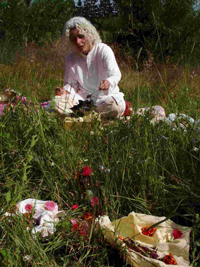|
|
Sacha Stupa on the island of Fyn, Denmark
In the countryside of Fyn, on the northern side of Svanninge Bakker at Sacha Kutir, stands Sacha Stupa, a temple for prayer and meditation. Sacha is built as a three dimensional form of the Sacha Mandala. The stupa enshrines a pole symbolising The Tree of Life. It contains 448 small Medicine Buddhas as well as sacred artifacts from various spiritual trandtions and masters. The inner chamber encloses just as much space within the earth as the upper chamber, from the ground upwards, comprises. A carved wooden door allows the possibility to go inside. For more information about the stupa and how to visit, visit Sacha Kutir's website: www.sachakutir.dk/stupa.htm.
The building process of the stupa The site for the stupa was consecrated on the 17th of July 2004. Fitting astrological calculations, a Havan fire ceremony, was performed there at 10:08 am. The foundation was laid when ShantiMayi was in Denmark in May 2005. Many people from the sangha participated during those few very intense and profound days. The stupa as a 3-dimensionally shapedSacha Mandala The shape itself came into being through close work between ShantiMayi and Sunyata, who was in charge of construction. An oak tree pole stands at the center, reaching from the foundation up to the apex of the dome, acting as an acupuncture needle healing our planet. All measurements of the construction can be divided by the number 9, the symbol of perfection, of the beginning and the end. The above picture of the stupa model is from May 2005. This picture shows how the stupa's form evolved during construction. The Three Mantras Prabhu Aapa Jago, Prabhu Aapa Jago,Prabhu Aapa Jago, Paramatma JagoMere Sarva Jago, Sarvatra Jago,Prabhu Aapa Jago, Paramatma JagoTranslation: O God awake, awake within me.You are everywhere in all places,Awake.Tiny Medicine Buddha statues for the stupa were made during ShantiMayi’s visit in Denmark, May 2005 and during the summer camp of 2006. The foundation of the Stupa East In between these boulders are smaller rocks and together they form an outer circle. The rocks are painted in blue and green for the sky and the earth. The copper spiral and oak tree pole ShantiMayi brought a double dorge, which was placed in the middle of the copper spiral. The double-dorge is a Tibetan symbol for the beginning of time when all form came into being. It also represents the masculine and feminine aspects. There is a space just above the double-dorge where a huge crystal was placed during the consecration ceremonies. The crystal was previously mentally filled with prayers for the world. Spiralling out from the center of the circle are smaller stones gathered by the sangha. All the stones and boulders, together with the copper spiral, make up the foundation of the stupa. Each person who had picked a stone, has mentally filled that stone with prayers for the world. Sand from the holy Ganges River was strewn on the foundation together with ash and flowers from the fire ceremonies. On completion of the entire foundation, it was covered with cement, leaving a small hole so the large crystal could be placed inside. The wall of the underground section of the stupa and the greyish area to the right, is the chamber entrance. |
|
|
|

















